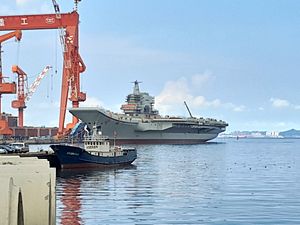The Chinese People’s Liberation Army Navy’s (PLAN) first domestically designed and built aircraft carrier, the Type 002 (CV-17), which has yet to be named, returned from a fourth round of sea trials in the Yellow Sea to the Dalian Shipbuilding Industry Company (DSIC) shipyard, located in the port of Dalian in China’s Liaoning province, on January 8.
The latest round of sea trials reportedly involved flyover tests and touchdowns on the deck conducted by three Shenyang J-15 multirole fighter jets. The new carrier could be commissioned as early as April 2019. “The vessel has probably completed 80 to 90 percent of the necessary tests,” Beijing-based military expert Li Jie was quoted as saying by the South China Morning Post on January 10. “I think it’s possible it can be delivered by the Chinese Navy Day on April 23.”
A previous round of sea trials of the carrier, previously designated Type 001A and expected to be named Shandong, took place in October in the northern Yellow Sea. This was preceded by a round of sea trials in August and September. The carrier took to the open sea for the first time in May 2018. This first round of sea trials, which took place in the northeastern part of the Bohai Sea, primarily tested the reliability of the flattop’s power and propulsion systems.
As I wrote in 2018, the PLAN’s first domestically built carrier is a derivative of Soviet Navy carrier designs:
The 65,ooo-ton Type [002] carrier was launched at the DSIC shipyard in April 2017. The warship is an improved variant of the PLAN’s only operational aircraft carrier, the 60,000-ton Type 001 Liaoning — a retrofitted Soviet-era Admiral Kuznetsov-class multi-role aircraft carrier. (…)
The [yet-to-be-named carrier] has been fitted with a so-called ski-jump assisted Short Take-Off But Arrested Recovery (STOBAR) launch system also installed aboard the Liaoning. STOBAR-launched aircraft have a more limited operational range and carry lighter payloads than fighter jets launched from so-called Catapult-Assisted Take-Off But Arrested Recovery (CATOBAR) systems used on U.S. Navy carriers. (STOBAR systems put a lot of strain on the airframe of fighter jets during take-off.)
The [future] Shandong will be able to carry up to 24 Shenyang J-15 multirole fighter jets and a variant of the fourth-generation Sukhoi Su-33 twin-engines air superiority fighter, as well as around ten rotary wing aircraft including Changshe Z-18, Ka-31, or Harbin Z-9 helicopters.
Chinese naval officials have claimed that the carrier will be able to accommodate a total of up to 32 J-15s. Notably, the Type 002 has reportedly been fitted with a new advanced electronically scanned array (AESA) radar system and a new bridge.
Once activated, the flattop will likely serve in the PLAN’s North Sea Fleet or East Sea Fleet.

































